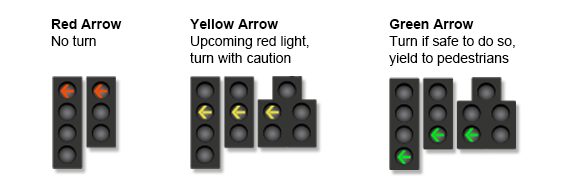Blinking traffic lights can be confusing, especially if you’re not used to seeing them on your normal commute. Let’s take a look at the different types of traffic lights you’ll encounter on the road.
Steady Lights

Most of us are already familiar with steady traffic lights, but we’ll review them again just in case.
Steady Red Light
When you see a steady red light, you need to stop before entering the crosswalk or intersection. You can usually turn on a steady red light, as long as there’s not a "No Turn on Red" sign, or other signal prohibiting you from doing so. You can usually turn left on red when both of the streets are one-way, unless there’s a sign telling you not to turn on red.
Steady Yellow Lights
When you see a steady yellow light, get ready to stop! It’s tempting to speed up and make it through the intersection before the light turns red, but those few extra seconds you save aren’t worth the risk of getting into a collision. If you’re not able to stop safely before entering the intersection, go ahead and cautiously drive through the yellow light.
Steady Green Light
When the light is green, you have the right-of-way and you get to go as long as the intersection is clear. You should be able to turn right, as long as there’s no sign telling you not to turn.
The most dangerous time to enter an intersection is immediately after the light has turned green. Drivers tend to run red lights, so you need to be cautious before entering the intersection even when your light is green.
Arrows

Traffic signal arrows let you know when you’re allowed to turn. A steady red arrow means you have to stop and yield the right-of-way. Steady yellow arrows let you know the light is about to turn red and you need to be prepared to stop. You shouldn’t speed through the intersection to try to make it before the arrow turns red.
Green arrows mean you have the right-of-way and it’s your turn to turn. Keep an eye out for pedestrians and other vehicles in the intersection before making your turn.
Blinking Lights

Blinking (also called flashing) lights require your full attention.
Flashing Yellow Lights
Flashing yellow lights mean you need to slow down, but you do not have to stop as long as the intersection is clear.
A flashing yellow arrow means you can make a left turn as long as it’s clear and safe to do so. You’ll usually see a flashing yellow arrow before or after a protected green light or solid yellow arrow. Flashing yellow arrows help to improve traffic flow and allow drivers to avoid unnecessary stops. As a driver, you must use your best judgement and only turn on a flashing yellow arrow when you have plenty of time to safely complete the turn.
Flashing Red Lights
Flashing red lights are treated the same as a stop sign. When you approach a flashing red light, come to a complete stop before reaching the intersection or crosswalk. If cross traffic isn’t required to stop, remain stopped until the roadway is clear and you can safely drive through the intersection. If cross traffic is required to stop, follow the same rules of right-of-way as if you’re at a four-way stop sign.
When you see a flashing red arrow, come to a complete stop and yield the right-of-way to oncoming traffic. Turn in the direction of the arrow when it’s safe to do so.
Next time you see a blinking yellow light, you’ll know the difference between it and a solid yellow light!
Let us help prepare you for any driving situation. Taking an online defensive driving course or an insurance discount course is a great way to help prepare you for any type of driving situation! Click here to visit our website to see the online courses we offer in your state!